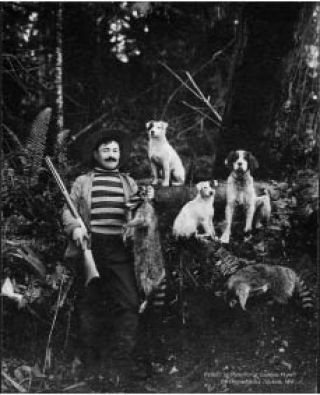In many Washington communities, deer hunting season is an annual event welcomed by throngs of orange-clad sportsmen and women. Not so on Bainbridge.
“It’s amazing how many people I’ve talked to on Bainbridge over the last five years that have been aghast to find out hunting is legal on the island,” Bainbridge Police Chief Matt Haney said.
Deer season wraps up this week, and on Bainbridge a few recent incidents have raised questions about where and when hunting is legal on Bainbridge.
On Nov. 7, Tolo Road resident Robert Dashiell watched a buck wander into his yard with an arrow lodged in its hindquarter. On Nov. 14, Richard LaBotz, a Springridge Road resident, called 911 after encountering a man on his property with a shotgun and a dog as he walked toward Gazzam Lake Park.
The bottom line is that game hunting is legal on Bainbridge, if the hunter has the permission of the property owner and is hunting within seasons and guidelines dictated by the state Department of Fish and Wildlife, Bainbridge Police Lt. Chris Jensen said.
Under state law, hunting with modern rifles is not allowed on the island, which limits hunters to shotguns, pistols, black powder firearms and bows. The small number of people who hunt on Bainbridge each year tend to be bow hunters, Jensen said.
Firearms and explosives are not allowed on land managed by the Bainbridge Metropolitan Park and Recreation District. Jensen said hunting isn’t expressly prohibited on city-managed open space, but a prospective hunter would have to gain permission from the city to harvest game there. Jensen said he has never heard of a hunter making that request.
People born later than 1972 are required to complete a hunter-safety course before being issued a hunting permit. Islander James Walkowski has volunteered to lead hunter safety courses for WDFW for 36 years, and said the courses he offers at the Bainbridge Island Sportsmen’s Club are well attended.
Walkowski doesn’t hunt on Bainbridge anymore, but used to harvest migratory ducks and raccoons for his dinner table. He stresses that hunting is a relatively safe sport. In 2007, Washington hunters logged more than 3.5 million hours in the field and only five hunting-related accidents were reported.
Hunting has been a tradition on Bainbridge since long before Europeans landed on its shores. The island’s lush inland was a favored hunting ground for the Suquamish tribe. Hunting remained an integral part of life for settlers, and was popular well into the 20th century.
The recent spike in population and shrinking of open space has made it more difficult for hunters to find sufficient room to safely shoot.
“Twenty years ago no one noticed the dozen hunters that were out in the woods,” Jensen said. “Now with the increase in the population and the decrease in property size, we’re getting calls about four or five a year.”
The man LaBotz encountered near Gazzam Lake Park was a longtime islander who had hunted in the area in the past, said Jensen, who responded to the 911 call.
Jensen said the man was unaware that the property had changed hands and was now a managed public park. The man’s shotgun was not loaded. Jensen discussed hunting rules with the man but did not issue a citation.
One conflict that arises from hunting in populated areas comes from wounded animals.
By law, a hunter that wounds an animal must track it and finish the kill. Hunters are allowed to track the animal onto neighboring properties – even if they don’t have permission to hunt there.
“Usually that’s when we get a call,” Jensen said. “When someone sees a guy go through their yard with a bow and arrow.”
Whoever shot the buck Dashiell encountered, failed to finish the hunt.
Deer are frequent visitors to Dashiell’s Tolo Road property, but he noticed that the two-point buck that wandered into his yard Nov. 7 appeared shaky. Upon closer inspection he saw an arrow stuck in its right hindquarter.
“It was in pretty deep, I’d guess two or three inches,” Dashiell said.
Knowing deer can be dangerous at close quarters, Dashiell didn’t attempt to approach the buck. He reported the sighting to West Sound Wildlife Shelter and shot a few seconds of video as it jogged away.
Mike Pratt, wildlife specialist at West Sound Wildlife Shelter, said shelter staff have so far been unable to locate the buck, but it seemed to be surviving. Pratt said the shelter takes in 10 to 20 animals from the west-sound region injured by weapons each year. It also receives a few calls from island residents regarding hunters – usually bow hunters during the fall deer season.
Pratt said the majority of the animals that arrive at the shelter with injuries inflicted by weapons appear to have been wounded by people who weren’t following laws and responsible hunting practices.
“Many of these people I don’t consider as hunters…they’re just irresponsible people with guns,” he said. “Good hunters don’t do that.”



